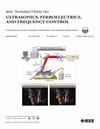A Contrast-Enhanced Null Subtraction Imaging Method Using Dynamic DC Bias in Ultrafast Ultrasound Imaging
IF 3.7
2区 工程技术
Q1 ACOUSTICS
IEEE transactions on ultrasonics, ferroelectrics, and frequency control
Pub Date : 2025-04-04
DOI:10.1109/TUFFC.2025.3558017
引用次数: 0
Abstract
Enhancing the resolution and contrast of ultrafast ultrasound imaging is imperative for the accuracy of clinical diagnostics. Null subtraction imaging (NSI) is a nonlinear beamforming technique capable of significantly enhancing lateral resolution. However, it suffers from issues of low-quality speckle pattern and poor contrast performance. To address this issue, we propose a novel contrast-enhanced NSI method that utilizes dynamic dc bias. Innovatively, we construct the dynamic dc bias using a generalized coherence factor (GCF) and a sigmoid transformation function that adapts the dc value based on the signal characteristics of different imaging regions. Furthermore, a normalization scheme is proposed to optimize the beamforming output, ensuring uniform pixel intensity throughout the final image. Simulation, phantom, and in vivo data are utilized for ultrasound beamforming to evaluate the performance of the proposed method. Quantitative results show that the proposed method significantly enhances the contrast ratio (CR) by 197%, the contrast-to-noise ratio (CNR) by 341%, the speckle signal-to-noise ratio (sSNR) by 302%, and the generalized CNR (gCNR) by 106% compared to the original NSI (in phantom). Point target imaging results indicate that the proposed method achieves a main lobe width slightly wider than the original NSI method, but much narrower than those of delay and sum (DAS) and GCF. These findings confirm that the proposed method significantly enhances imaging contrast while preserving high resolution, which is of great significance for the further clinical application of ultrafast ultrasound imaging.一种利用动态直流偏置进行超快超声成像的对比度增强零差成像方法。
提高超快超声成像的分辨率和对比度对临床诊断的准确性至关重要。零相减成像(NSI)是一种能够显著提高横向分辨率的非线性波束形成技术。然而,它存在低质量斑点图案和对比度差的问题。为了解决这个问题,我们提出了一种利用动态直流偏置的对比度增强NSI方法。创新地,我们使用广义相干因子(GCF)和基于不同成像区域的信号特征自适应DC值的s型变换函数来构建动态DC偏置。此外,提出了一种优化波束形成输出的归一化方案,以确保最终图像中的像素强度均匀。仿真、模拟和体内数据被用于超声波束成形来评估所提出的方法的性能。定量结果表明,与原始NSI(在幻影中)相比,该方法显著提高了对比度(CR) 197%,噪比(CNR) 341%,散斑信噪比(sSNR) 302%,广义噪比(gCNR) 106%。点目标成像结果表明,该方法获得的主瓣宽度比原NSI方法略宽,但比DAS和GCF方法窄得多。以上结果证实了该方法在保持高分辨率的同时,显著增强了成像对比度,对超快超声成像的进一步临床应用具有重要意义。
本文章由计算机程序翻译,如有差异,请以英文原文为准。
求助全文
约1分钟内获得全文
求助全文
来源期刊
CiteScore
7.70
自引率
16.70%
发文量
583
审稿时长
4.5 months
期刊介绍:
IEEE Transactions on Ultrasonics, Ferroelectrics and Frequency Control includes the theory, technology, materials, and applications relating to: (1) the generation, transmission, and detection of ultrasonic waves and related phenomena; (2) medical ultrasound, including hyperthermia, bioeffects, tissue characterization and imaging; (3) ferroelectric, piezoelectric, and piezomagnetic materials, including crystals, polycrystalline solids, films, polymers, and composites; (4) frequency control, timing and time distribution, including crystal oscillators and other means of classical frequency control, and atomic, molecular and laser frequency control standards. Areas of interest range from fundamental studies to the design and/or applications of devices and systems.

 求助内容:
求助内容: 应助结果提醒方式:
应助结果提醒方式:


